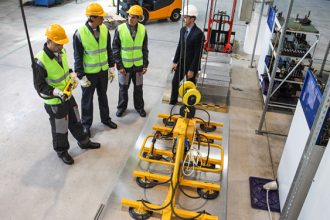Hoist Chain Container Best Practices

When a hoist is equipped with a load chain to lift or lower a load, there is often excess slack chain hanging from the unit. This slack load chain can interfere with the load, the adjacent load chain, or even the operator during hoisting operations. To prevent this interference, a chain container connected below the hoist body can be used. Chain containers—which come in a variety of materials (molded plastic, fabric), shapes (rounded, rectangular, contoured), and attachment styles (suspended or fixed)—capture and store excess hoist load chain on the no-load side of the hoist’s sheaves.
According to ASME B30.16 Section 16-1.3.3(g), “Where the slack load chain hanging from the hoist may create a hazard to operations or personnel, a chain container recommended by the hoist manufacturer or a qualified person should be used.”
There are several recommended best practices for the design and use of hoist chain containers that further ensure operational safety. These include:
- The chain container should be designed by a qualified hoist engineer or the hoist’s original equipment manufacturer (OEM) to ensure that the device is suitable for its intended use.
- The chain container should be designed with sufficient volume, strength, and capacity to hold the entire lift length of the hoist’s chain and to collect it in alignment with the chain’s stacking mode.
- The design of the chain container should not interfere with the hoist’s operation or performance.
- Application-specific requirements (such as clearance from obstructions, the materials used, and environmental considerations) should be considered by the hoist chain container engineer during the design process.
- Verify that the chain container is installed correctly and that the no-load chain is terminated as per the manufacturer’s instructions.
- Do not permit operators to make any alterations to the chain container’s design.
- Train operators to avoid contact between the load, the load fixture, and the chain container.
- Inspect the chain container regularly to ensure its hardware (brackets, links, fasteners and other supports), container material, and attachment are in proper working condition.
- Replace any chain container that shows signs wear or damage prior to using the hoist.
- Ensure that the load chain, container fasteners, and other hardware are properly maintained in accordance with the OEM’s recommendations.
Want more details about the safe operation of hoists? The members of the Hoist Manufacturers Institute (HMI) offer a variety of resources, including The Hoist Operator’s Manual (HMI100.23), which describes the different types of hoists as well as the responsibilities and duties of hoist operators. It also explains the motions of hoists and trolleys, and the operation of manual, electric, and air powered hoists. The document further details the need for routine hoist inspection, maintenance, and repair to prevent problems that may lead to equipment failures and possible worker injuries. Likewise, an Operator’s Manual specific to Lever Hoists (HMI100.75) is also available.



